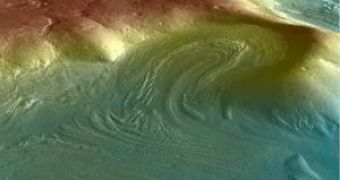Mars is often viewed as a planet that has been climatically active in a distant past, having flowing water on its surface as early as 3.5 billion years ago. At some point in time around this date, Mars' clime took a turning point rendering it much as the way we see it today. New discoveries made with the Mars Reconnaissance Orbiter reveal that Mars' clime may have been in fact much more active than previously thought, and as recently as 100 or maybe 10 million years ago.
High resolution images relayed by the MRO show that Mars' mid-latitude areas could have had flowing glaciers, and ice packs between 1 to 2.5 kilometers thick which may answer the question whether or not Mars' had or may support life in a distant future. "We've gone from seeing Mars as a dead planet for three-plus billion years to one that has been alive in recent times. The finding has changed our perspective from a planet that has been dry and dead to one that is icy and active," says Brown University's Department of Geological Sciences investigator, Jay Dickson.
According to planetary geologists James Head and David Marchant at Boston University' Department of Earth Sciences, and co-authors of the study, Mars may have had multiple ice ages which covered the mid-latitude regions of the planet with glaciers, possibly triggered by climate changes involving altering sunlight concentrations in some areas of the Red Planet.
The area referred to in their study is located in a mid-latitude region of the planet dominated by massifs and steep-walled valleys known as Protonilus Mensae-Coloe Foassae. This particular canyon presents features similar to that produced by the retreat and advance of glaciers, moraines, with one baffling difference; rock pattern show that instead of moving downwards, the glacier seems to have flowed in the opposite direction, which is impossible of course.
The team interpreted the finding as evidence that ice in the surrounding areas may have grew considerably higher than the canyon wall, and then flowed over the canyon. To do so, the ice pack would have had to reach a thickness of at least one kilometer or more, probably up to 2.5 kilometers during ice sheet thickness peak.
The thickness of the ice could have melted water either through temperature or pressure, which may have significant implications for life on the Red Planet, although it is widely believed that Mars' clime is mostly driven by sublimation processes. The fact that the team also found semi-circular moraine in the lobe across the valley from the box site suggests that two glaciation periods occurred relatively recently, therefore the clime may have been through ice ages.

 14 DAY TRIAL //
14 DAY TRIAL //